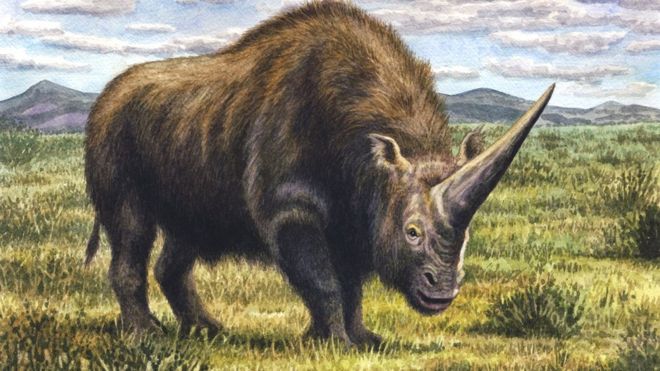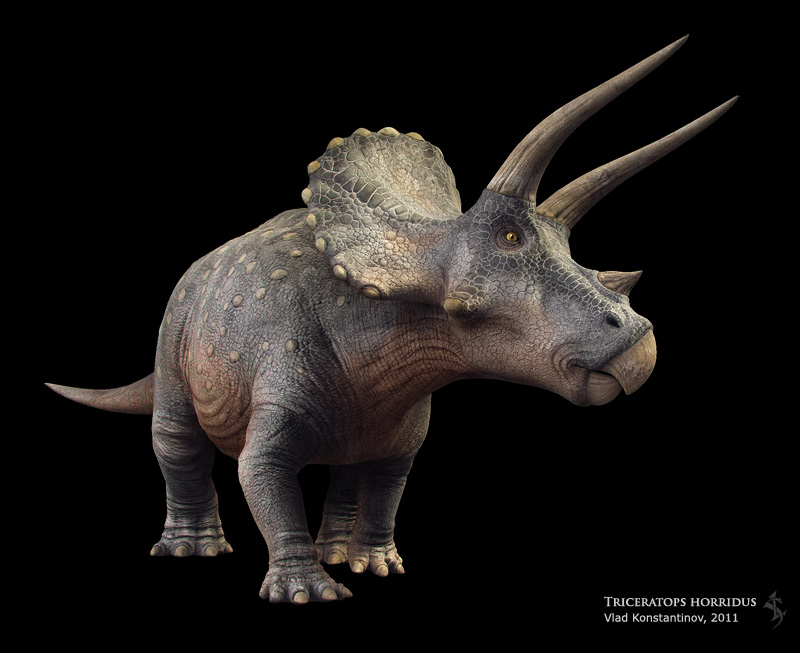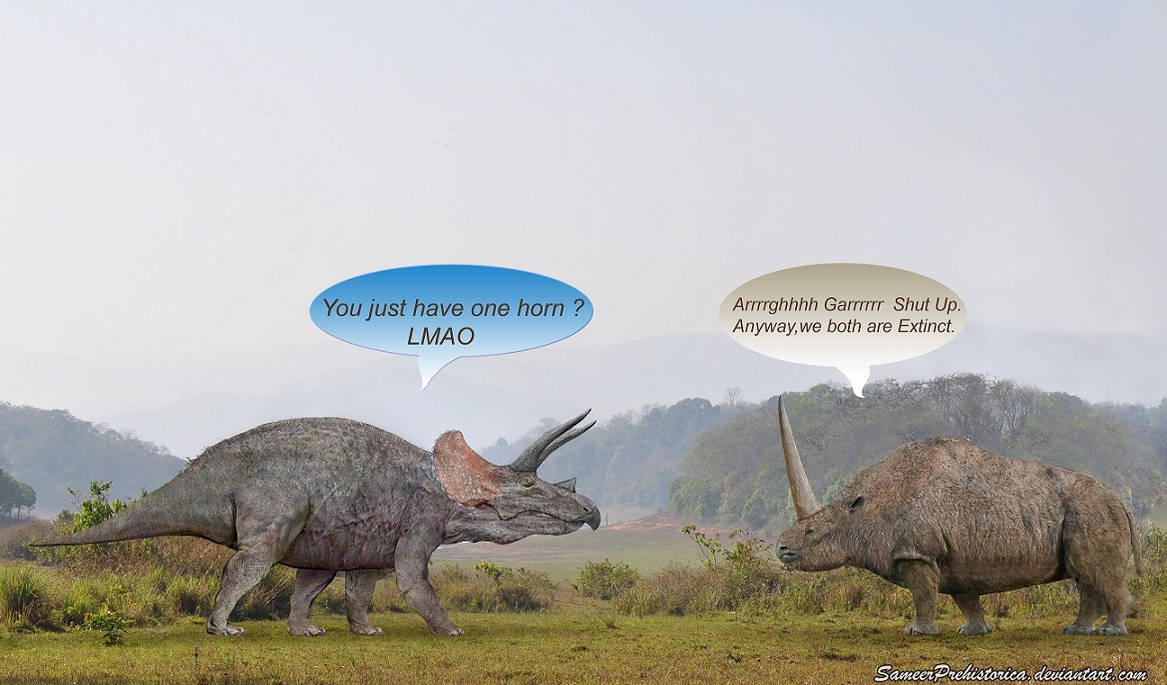Post by dinosauria101 on Jun 12, 2019 15:10:32 GMT 5
Elasmotherium sibiricum
Elasmotherium ("thin plate beast") is an extinct genus of large rhinoceros endemic to Eurasia during the Late Pliocene through the Pleistocene, existing from 2.6 Ma to at least as late as 39,000 years ago in the Late Pleistocene. E. sibiricum, was the size of a mammoth and is thought to have borne a large, thick horn on its forehead. Theories about the function of this horn include defence, attracting mates, driving away competitors, sweeping snow from the grass in winter and digging for water and plant roots. Like all rhinoceroses, elasmotheres were herbivorous. Unlike any others, its high-crowned molars were ever-growing. Its legs were longer than those of other rhinos and were adapted for galloping, giving it a horse-like gait. The known specimens of E. sibiricum reach up to 4.5 m (15 ft) in body length with shoulder heights over 2 m (6 ft 7 in). Elasmotherium weighed 4.5-5 ton.

Triceratops horridus
Triceratops ( /traɪˈsɛrətɒps/ try-serr-ə-tops) is a genus of herbivorous ceratopsid dinosaur which lived during the late Maastrichtian stage of the Late Cretaceous Period, around 68 to 65 million years ago (Mya) in what is now North America. It was one of the last dinosaur genera to appear before the great Cretaceous–Paleogene extinction event. The term Triceratops, which literally means "three-horned face," is derived from the Greek τρί- (tri-) meaning "three", κέρας (kéras) meaning "horn", and ὤψ (ops) meaning "face". Bearing a large bony frill and three horns on its large four-legged body, and conjuring similarities with the modern rhinoceros, Triceratops is one of the most recognizable of all dinosaurs and the best known ceratopsid. It shared the landscape with and was preyed upon by the fearsome Tyrannosaurus, though it is less certain that the two did battle in the manner often depicted in traditional museum displays and popular images. The exact placement of the Triceratops genus within the ceratopsid group has been debated by paleontologists. Two species, T. horridus and T. prorsus, are considered valid although many other species have been named. Recent research suggests that the contemporaneous Torosaurus, a ceratopsid long regarded as a separate genus, actually represents Triceratops in its mature form. Triceratops has been documented by numerous remains collected since the genus was first described in 1889, including at least one complete individual skeleton. Paleontologist John Scannella observed: "It is hard to walk out into the Hell Creek Formation and not stumble upon a Triceratops weathering out of a hillside." Forty-seven complete or partial skulls were discovered in just that area during the decade 2000–2010. Specimens representing life stages from hatchling to adult have been found. The function of the frills and three distinctive facial horns has long inspired debate. Traditionally these have been viewed as defensive weapons against predators. More recent theories, noting the presence of blood vessels in the skull bones of ceratopsids, find it more probable that these features were primarily used in identification, courtship and dominance displays, much like the antlers and horns of modern reindeer, mountain goats, or rhinoceros beetles. The theory finds additional support if Torosaurus represents the mature form of Triceratops, as this would mean the frill also developed holes (fenestrae) as individuals reached maturity, rendering the structure more useful for display than defense. Individual Triceratops are estimated to have reached about 7.9 to 9.0 m (26-30 ft) in length, 2.9 to 3.0 m (9.5–9.8 ft) in height, and 6.1–12.0 tonnes (13,000–26,000 lb) in weight. The most distinctive feature is their large skull, among the largest of all land animals. The largest known skull (specimen BYU 12183) is estimated to have been 2.5 metres (8.2 ft) in length when complete, and could reach almost a third of the length of the entire animal. It bore a single horn on the snout, above the nostrils, and a pair of horns approximately 1 m (3 ft) long, with one above each eye. To the rear of the skull was a relatively short, bony frill, adorned with epoccipitals in some specimens. Most other ceratopsids had large fenestrae in their frills, while those of Triceratops were noticeably solid. The skin of Triceratops was unusual compared to other dinosaurs. Skin impressions from an as-yet undescribed specimen show that some species may have been covered in bristle-like structures, similar to the more primitive ceratopsian Psittacosaurus.

Credit to Wikipedia
NOTE: I know this may seem a bit redundant given the similar thread with Torosaurus, as well as unfair given the size difference, but I think it was viewed as fair and distinct on Carnivora, Animalia Enthusiasts, and 1 more site (Dinosaur Pivoting Forum?) by several members that are here, so I think it'd work
Elasmotherium ("thin plate beast") is an extinct genus of large rhinoceros endemic to Eurasia during the Late Pliocene through the Pleistocene, existing from 2.6 Ma to at least as late as 39,000 years ago in the Late Pleistocene. E. sibiricum, was the size of a mammoth and is thought to have borne a large, thick horn on its forehead. Theories about the function of this horn include defence, attracting mates, driving away competitors, sweeping snow from the grass in winter and digging for water and plant roots. Like all rhinoceroses, elasmotheres were herbivorous. Unlike any others, its high-crowned molars were ever-growing. Its legs were longer than those of other rhinos and were adapted for galloping, giving it a horse-like gait. The known specimens of E. sibiricum reach up to 4.5 m (15 ft) in body length with shoulder heights over 2 m (6 ft 7 in). Elasmotherium weighed 4.5-5 ton.

Triceratops horridus
Triceratops ( /traɪˈsɛrətɒps/ try-serr-ə-tops) is a genus of herbivorous ceratopsid dinosaur which lived during the late Maastrichtian stage of the Late Cretaceous Period, around 68 to 65 million years ago (Mya) in what is now North America. It was one of the last dinosaur genera to appear before the great Cretaceous–Paleogene extinction event. The term Triceratops, which literally means "three-horned face," is derived from the Greek τρί- (tri-) meaning "three", κέρας (kéras) meaning "horn", and ὤψ (ops) meaning "face". Bearing a large bony frill and three horns on its large four-legged body, and conjuring similarities with the modern rhinoceros, Triceratops is one of the most recognizable of all dinosaurs and the best known ceratopsid. It shared the landscape with and was preyed upon by the fearsome Tyrannosaurus, though it is less certain that the two did battle in the manner often depicted in traditional museum displays and popular images. The exact placement of the Triceratops genus within the ceratopsid group has been debated by paleontologists. Two species, T. horridus and T. prorsus, are considered valid although many other species have been named. Recent research suggests that the contemporaneous Torosaurus, a ceratopsid long regarded as a separate genus, actually represents Triceratops in its mature form. Triceratops has been documented by numerous remains collected since the genus was first described in 1889, including at least one complete individual skeleton. Paleontologist John Scannella observed: "It is hard to walk out into the Hell Creek Formation and not stumble upon a Triceratops weathering out of a hillside." Forty-seven complete or partial skulls were discovered in just that area during the decade 2000–2010. Specimens representing life stages from hatchling to adult have been found. The function of the frills and three distinctive facial horns has long inspired debate. Traditionally these have been viewed as defensive weapons against predators. More recent theories, noting the presence of blood vessels in the skull bones of ceratopsids, find it more probable that these features were primarily used in identification, courtship and dominance displays, much like the antlers and horns of modern reindeer, mountain goats, or rhinoceros beetles. The theory finds additional support if Torosaurus represents the mature form of Triceratops, as this would mean the frill also developed holes (fenestrae) as individuals reached maturity, rendering the structure more useful for display than defense. Individual Triceratops are estimated to have reached about 7.9 to 9.0 m (26-30 ft) in length, 2.9 to 3.0 m (9.5–9.8 ft) in height, and 6.1–12.0 tonnes (13,000–26,000 lb) in weight. The most distinctive feature is their large skull, among the largest of all land animals. The largest known skull (specimen BYU 12183) is estimated to have been 2.5 metres (8.2 ft) in length when complete, and could reach almost a third of the length of the entire animal. It bore a single horn on the snout, above the nostrils, and a pair of horns approximately 1 m (3 ft) long, with one above each eye. To the rear of the skull was a relatively short, bony frill, adorned with epoccipitals in some specimens. Most other ceratopsids had large fenestrae in their frills, while those of Triceratops were noticeably solid. The skin of Triceratops was unusual compared to other dinosaurs. Skin impressions from an as-yet undescribed specimen show that some species may have been covered in bristle-like structures, similar to the more primitive ceratopsian Psittacosaurus.

Credit to Wikipedia
NOTE: I know this may seem a bit redundant given the similar thread with Torosaurus, as well as unfair given the size difference, but I think it was viewed as fair and distinct on Carnivora, Animalia Enthusiasts, and 1 more site (Dinosaur Pivoting Forum?) by several members that are here, so I think it'd work





